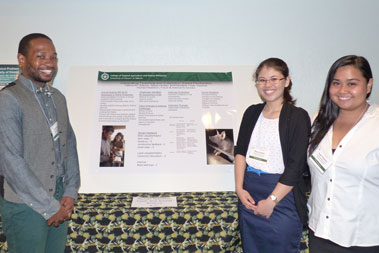
Swine Production is a senior capstone course in which students integrate concepts learned in courses such as nutrition, genetics and reproduction and apply them to practical swine production. Most animal science students at the University of Hawaii at Manoa are urban students interested in veterinary medicine, and little knowledge of or interest in swine production. The department learning objectives include applying principles to livestock production, but having students engage in learning the course material is a challenge.
The extension specialist teaching the course tried a new approach in fall, 2013, integrating instruction and extension. Instead of traditional classroom instruction and written reports, teams of three students were sent out to work with a cooperating farmer. The teams described their farm using a list of required information on general farm description, breeding program, feeding program, housing, waste management, health program, production management and economics. The farms were carefully selected to represent different management approaches including varying use of local food waste and agricultural byproducts in the swine rations and different types of housing and waste management. The teams presented the results of farm visits and farmer interviews in class presentations and written reports, which were revised before being submitted in final form to both the instructor and the farmer. The course was designated as developing both oral and written communication skills.
Course evaluations indicated that 78% of the students felt that the farm visits and interactions with the farmers were the most valuable part of the course, and 44% mentioned hands-on laboratories (artificial insemination and baby pig processing), while others mentioned constructive feedback, small class size, having to think, oral presentations, and writing. Student journals indicated a strong rapport with and a very positive view of the farmers and farm practices. The farmers changed some of their practices based on student recommendations, most notably adjusting feeding according to condition score. Student grades were assigned using posted rubrics and were equal to or better than in previous years in a more traditional learning environment.
The new structure had some challenges. Since this was the first time the course was taught using student engagement with producers, students were informed that some adjustment to assignments and grading rubrics might be made part way through the class and this in fact needed to be done. One example was development of a tool in which the relative contributions of the team members to the group reports were evaluated by all members of each team. Additionally, students were required to sign liability waivers and confidentiality agreements. Students had to use their own cars and to find times when all team members were available for farm visits. Students indicated that the amount of work justified 4 rather than 3 credits for the course. By Halina M. Zaleski, Maya Hester, Britt McNeill, Faye Toyama
Recommended Citation:
Zaleski, H.M., Hester, M., McNeill, B., Toyama, F. (2014, April). Integrating Teaching and Extension: Swine Production. Poster session presented at the Assessment for Curricular Improvement Poster Exhibit at the University of Hawai‘i at Mānoa, Honolulu, HI.
